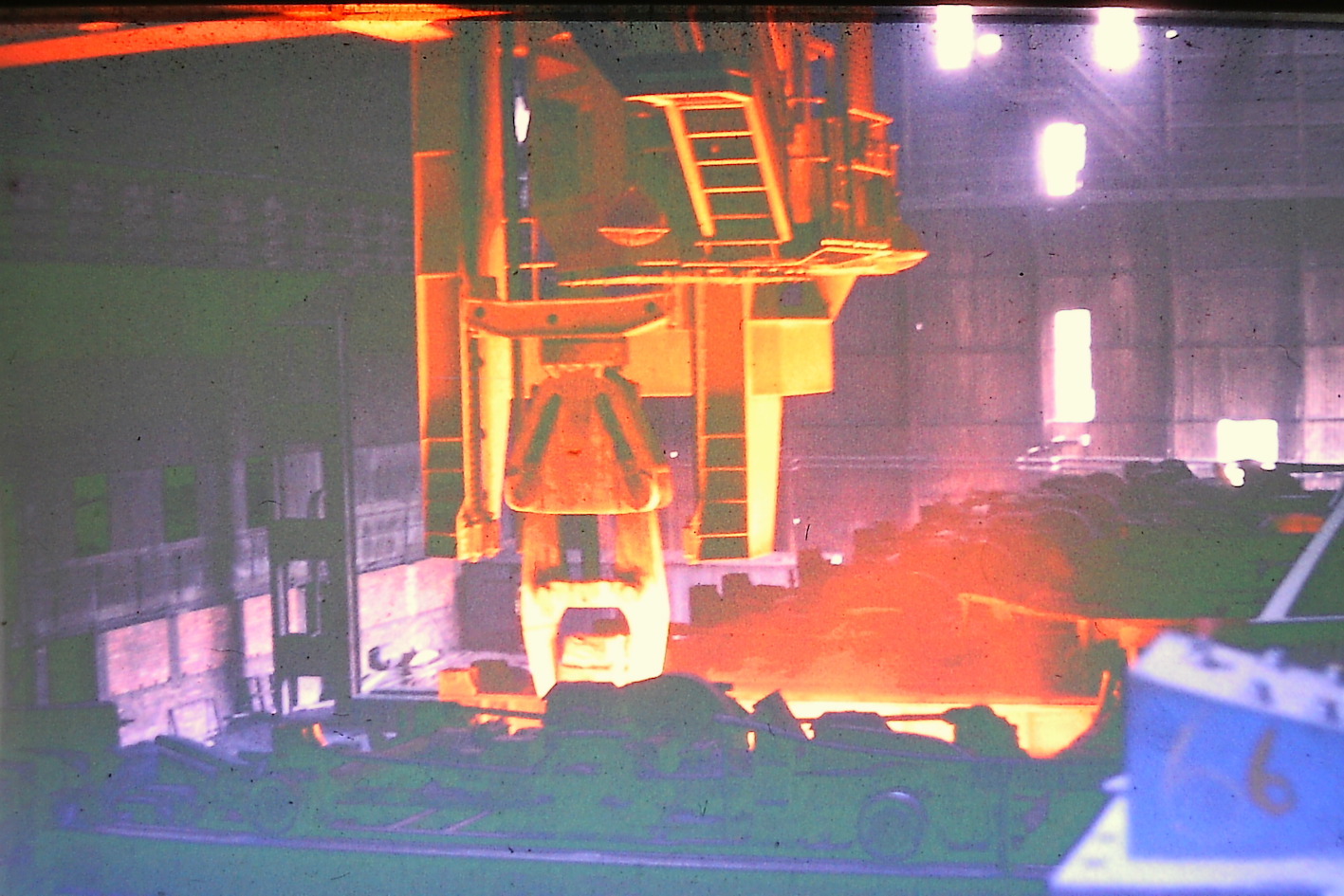
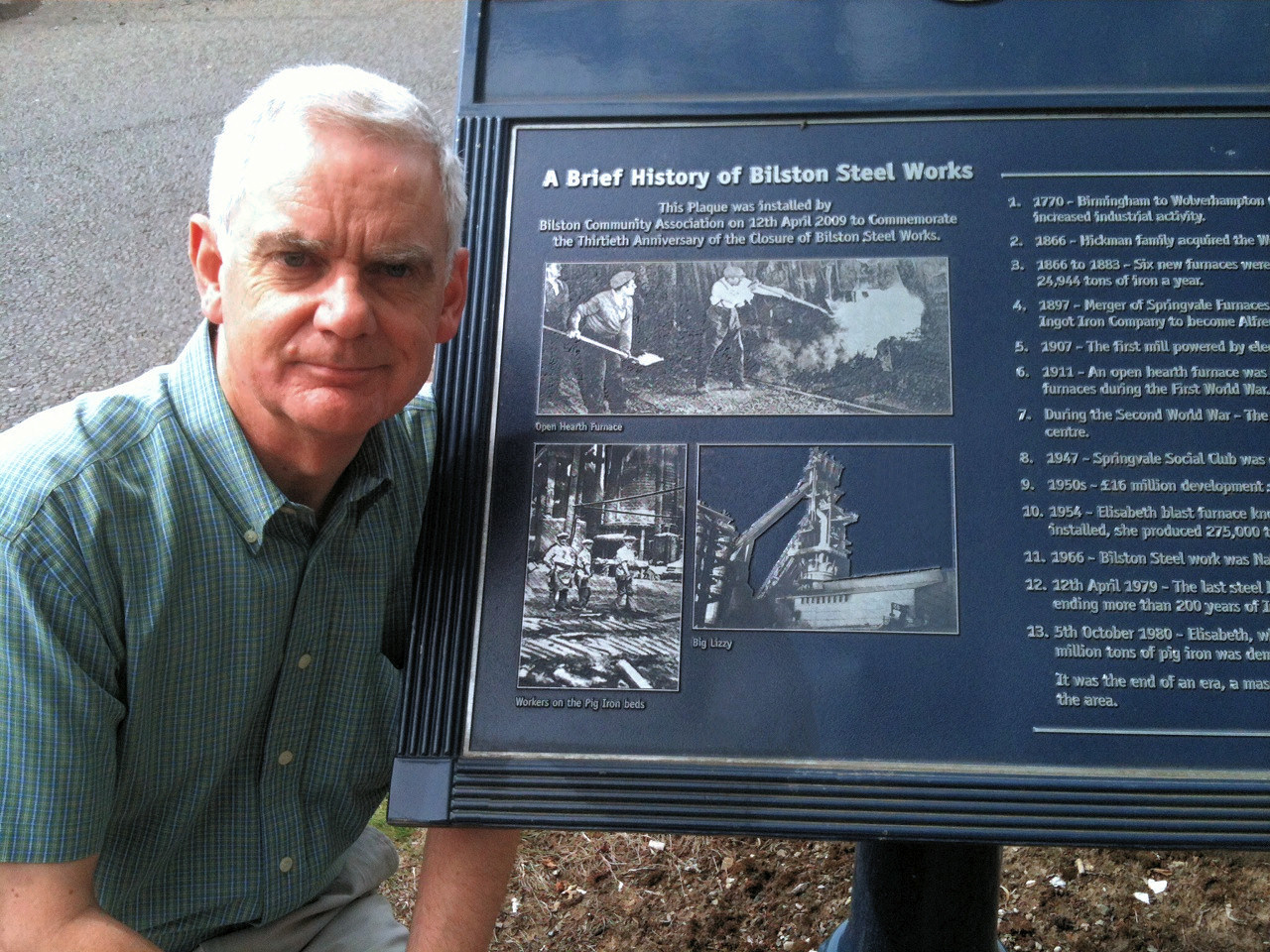
Welcome to this website on Bilston steelworks. If you stop here for awhile and check the date you will find that you have been transported back fifty years or so to around the year 1973 and the small town of Bilston, near Wolverhampton in the West Midlands of the UK. Travel half a mile or so along the Millfields Road to the west of the town and you will come to a place known as Spring Vale. This is where iron and steel making is still carried out just as it has been for two hundred years or more and the large blue and white sign outside the main gate clearly proclaims it to be Bilston Iron and Steelworks. The place where I, Andrew Simpson, spent the first six years of my working life, from 1972 to 1978. Today it is a housing estate and all that remained of the original site until recently was the Social Club and Training Centre. In 2019 however the Social Club was demolished leaving the Training Centre as the last building standing. This has at least been modernised and is in active use. As for the works itself, a chimney sculpture and plaque (above) may be glimpsed at the nearby traffic island, otherwise now, fifty years on, there is nothing visible to hint at what was once there….
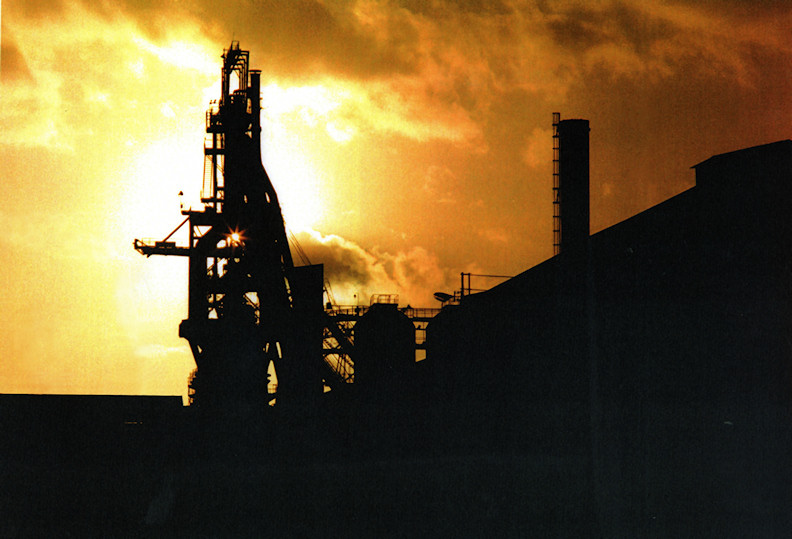
This is not a site to officially document Bilston steelworks, listing production records or a precise time line of events. It also does not cover the battle to save the works. Hopefully it will simply complement websites already established by others.
Here is a personal recollection of my time at Bilston supported by invaluable contributions from others and various archives with pictures, photographs – including those I took – various documents, some art, notably that of Harry Eccleston, newspaper articles and a transcript of my diary for 1973 which recorded my day-to-day life when I was a Commercial Trainee, mainly in the Blast Furnace Office. My interest at the time was the hot processing which fascinated me right from the start hence most pictures are all of either the No. 1 blast furnace – ‘Elisabeth’ – and the melting shop but none of the rolling mill. The rolling mill was of course impressive and believe me, if you stood on that little metal pedestrian bridge over the rollers connecting the soaking pits to the primary mill with shimmering red hot ingots trundling underneath you a few feet below, you were definitely ‘impressed’!! However, at the time, it did not catch my eye enough for me to use up precious film which is a shame and I accept that as a result of this visual coverage here is lacking. However for those who wish to know something about all the equipment and products of the works there is plenty of information under ‘Technical Information’ and ‘Plant and Equipment’.
So blast furnace ‘Elisabeth’ (with an ‘s’ not a ‘z’) first lit in 1954, was named after the daughter of Ian Stewart, chairman of then owners Stewarts & Lloyds and not the Queen as is often suggested, captured my attentions. Queen of Bilston to us however, Elisabeth was not a machine that could be switched on and off. She was a massive, fire breathing, iron making mountain of a furnace. She ran twenty-four hours a day and commanded the labours of all those around her who carefully managed her inputs and ouputs, paused her for necessary repairs and nursed her when sick. Visible for miles around she was the living heart of the works. I feel privileged to have ‘served under her’ even if only as an office trainee for a year and make no apologies for the amount of coverage she receives here.
Right: An ingot is lifted from the soaking pits ready for rolling to billet. Lower right : An example of one of the ubiquitous blue notes as used in the offices, similar to ‘Post It’ notes but without any sticky back !
<
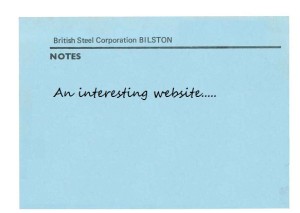
COMMERCIAL TRAINEE
Mrs Pamela Barham – Training Dept.
Mr Geoff Davies – Office Manager.
Mrs Letitia Nutting – Secretary
I was interviewed by Pamela Barham and Geoff Davies; offered the position of Commercial Trainee and commenced work on 1st August 1972. This entailed spending a six month period in various office departments with day release to study ONC Business Studies over two years at Wulfrun College near Compton, Wolverhampton.
1 August to 3 November 1972 : Wages Office
My first weeks of work were somewhat disappointing. Having arrived feeling highly qualified with six ‘O Levels’ expecting immediate executive work I was unprepared for the lowly routine of junior level office assisting and tea making ! The wages office was located on the ground floor in a concrete extension to the older general office building. My first foray into the ‘Dante’s Inferno’ of the melting shop came with journeys to and from the clocking in station to retrieve the workers clock cards initially accompanied by Arthur Bishop. This often required walking within a few feet of a train of freshly teemed, glowing red hot ingots which felt like walking within a few inches of an electric fire. I could not believe how dangerous this seemed to be and probably was although I don’t recall anyone getting injured while I was there. I remember that the most highly paid job in the melting shop was that of the de-gasser and I can still see the clock card now : Durkin, J. On Thursday afternoons the wages were prepared with cash tightly packed into transparent greaseproof packets. Some of them were tightly stuffed with notes. The wages were collected from a forecourt under the first floor of the general offices extension at the back of the office with all the hourly paid workers crowding and lining up at wicket windows on a Friday afternoon.
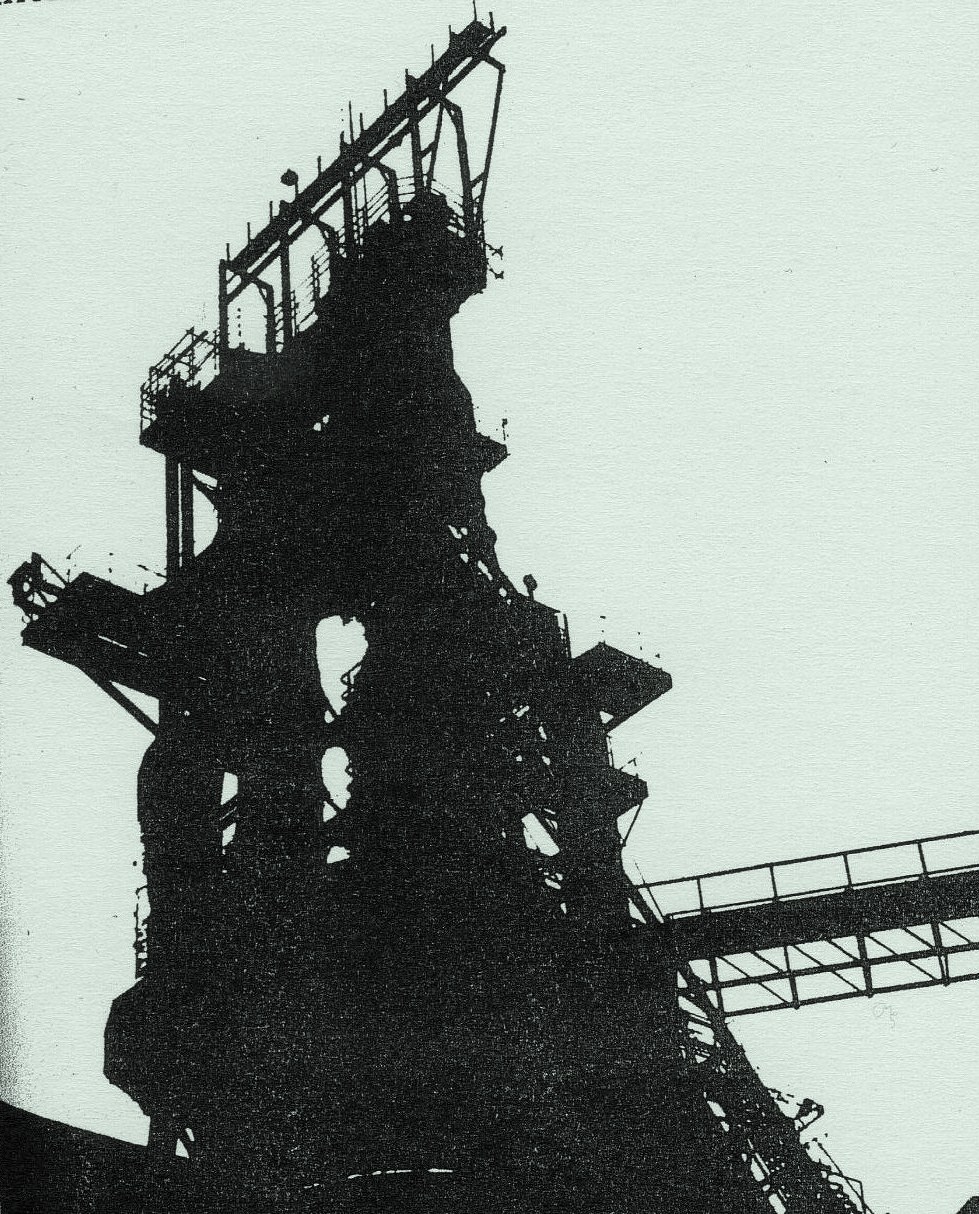
I was seventeen at the end of August 1972.
People I remember
- Joe Humpage – Manager
- Jim Larner – Assistant Manager
- Chris Christian
- Kevin Siverns (owner of a very nice silver-grey Ford Cortina Mk. II 1600E !)
- Arthur Bishop
- Arthur Griffiths

November 1972 to April 1973 : Cashiers Office
This was a relatively small office and quiet with two other people : Mr John McGraw and Dot Smith (thank you Roger Deans for the reminder of her surname). The manager was Ken Whitehouse who was a bit of a joker at times. If you read my diary from January to April you will see what sort of work occupied my days in there which consisted of clerical work associated with paying suppliers, pensions and cashing cheques for employees in the afternoon. The highlights were always my lunchtime forays into the works.Above: Sketch of the office from my diary-apologies for the poor renditions of Dot and John Mac
April 1973 to March 1974 : Blast Furnace Office
It was a great relief to me to depart from the sedate and quiet Cashiers office to what I expected would be a far more exciting place. In many ways it was but otherwise there was still a lot of routine work to be done.
Mr E. (Edward, but always ‘Ted’) Timmins was the sole occupant of the small office and I sat next to him during my time there. To others he generally referred to me as ‘the lad’. Ted must have been in his thirties and appeared to be a ‘fixture’ in the office, I do not know how long he had worked there. At some point in his past Ted must have injured his left knee since that leg was permanently straight. Ted was also a keen shooter and helped the department win trophies in several competitions at the works’ rifle range.
The blast furnace office itself was a relatively small and drab flat roofed concrete building. This could most easily be reached from near the General Offices via a pedestrian tunnel which ran under the highline. At ground level were the offices of David Hunter, Archie Woolley and those of the Blast Furnace Engineer, Walter Freeman and his clerk – David Cresswell. A set of external metal steps led to two upper offices – basically a divided concrete box on the roof of a bigger concrete box below, each with its own front door open to a flat rooftop with a handrail to the steps leading down. One was Ted’s and mine, next door was another office occupied by an elderly fellow called Ken Sudlow who I think did statistical work. While I was there Ken retired and was replaced by Jack Graham. Since the back of the office building actually formed part of the wall of the stockyard and with our door opening directly outside (at the front) it was a very dusty place ! Every day I would wipe a layer of dust off the desk….
The job was generally very routine as can be seen in my diary. Each morning I would call into the shift manager’s office (actually a small hut) located at ground level near the hot blast stoves and collect the A3 sized report sheet covering the past twenty four hours operation. This included the analyses of the four or five casts and slag flushes along with (I think) the number of charges (skips) with weights of iron ore, coke, mill scale, turnings and limestone. I would then continue and ascend up to the ‘highline’ which was where the railway wagons discharged into the bunkers. Each wagon had a ticket which was deposited into a box for me to collect although I seem to recall pulling tickets from individual wagons too.
I well remember the sources of some of the iron ore shipments we received. According to the published details on ‘Elisabeth’ she was designed to use low grade British ores and she did take a fair amount from Northampton called ‘Rushden Ore’. However the bulk was much richer and seemed to come either from Australia : ‘Hammersley Range’ or North Africa : ‘Cassinga’ and ‘Tazadit’ ore. I once picked up a piece of reddish dusty imported ore and washing it under a tap revealed a surprisingly shiny metallic silver nugget. However, disappointingly, when left for a day or so started to oxidise and rust ! The low grade Rushden ore was around 30% iron whereas the exotic lump of Australian ore I washed was 70-80% !
Most of the coke seemed to come from BSC’s Orgreave Works so my memory of Orgreave is that of a supplier – not a battleground. (Right: One of the Monday reporting sheets covering materials charged to Elisabeth over the previous week- click on the image to enlarge and use back arrow to return).
Sometimes Ted would ask me to buy his cigars from the shop counter in the works canteen manned by a friendly Polish lady who taught me ‘Dzien Dobry’ – ‘Good Morning’. Armed with all this I would sit next to Ted in my creaky chair and complete six forms, the blanks of each were on clipboards suspended next to Ted’s desk.
Part of the daily job was averaging out the chemistries of the casts and something called the ‘coke rate’ which was the amount of coke used per tonne of iron yielded. Unfortunately this was just before electric calculators became available and we had a mechanical calculator called a ‘Facit’ which was a sturdy metal box with a series of levers for units,tens, hundreds etc., a carriage slide and handle which you rotated and the little levers clicked and gave out a reading (see Diary 6 April). Making calculations was a time consuming and tedious affair. Shortly after moving into Sales I saw the first electric calculator which would have made this work ten times easier!
We also completed something called an NCR sheet which I often refer to in my diary; I think this was a compilation of the week’s results.
My memory of the days spent in this office are a mixture of tramping around the works either fetching or carrying papers or reports, going up and down the metal stairs to see Mr Hunter or Mr Woolley – again mainly for various tasks or errands. A constant stream of various people came into our dusty office where there was also a sink, kettle, various mugs, a transistor radio and a dartboard. The back wall of the office formed the wall of the stockyard which our back window overlooked. Part of the gantry track of the stockyard crane was fixed to the wall and the rumble of the crane was our daily background ‘music’. I remember other days in the summer where the door would be propped open and Ted would spout forth on various subjects he had been reading about – usually the war and people such as Churchill or Hirohito, the Japanese emperor. Politics often came up when others called in for a cup of tea. This is where I learned that political ‘discussions’ soon became heated and un-winnable. During lunchtimes (or dinnertime as it was then) Ted would usually go home and having been to the staff canteen I would be visited by fellow trainees such as Phil Davies or Paul Williams, for games of darts with Johnny Walker of Radio One on in the background.
I spent twelve months in the blast furnace office which was a ‘double shift’ since it should only have been six but the Training Officer (Linda Beards – who succeeded Pamela Barham ) asked me if I would stay on. Much as I loved being part of the blast furnace team I regretted agreeing to it and certainly that last three months dragged a little. I was ready for something different and my sights became firmly set on Sales.
People I Remember:
Mr. David Hunter – Blast Furnace Manager
A real character. Was 31 when he came to Bilston in 1970 from Normanby Park (see Steel News ‘Cool Reception for new boss!’). I believe he was very capable and practical with a quick mind and clear direction. He also possessed quite a salty vocabulary ! David Hunter smoked a pipe and also wore a shiny metal safety helmet whereas all others were made of white plastic or fibreglass. One abiding memory is of him coming into our office and while standing, putting a foot up on the edge of my desk to write his notes quickly and directly into the General Manager’s weekly report while tapping out his pipe on the side of the filing cabinet. In contrast, if Mr Hunter was away and Mr Woolley had to do the notes, he would take a long time to sit and draft them out on a separate piece of paper before carefully transcribing onto the actual report. I remember his car was a white Vauxhall Victor FD estate (1967-1972 model) which was parked along with all other management owned vehicles under cover in the compound where the garage for company cars was located at the rear of the General Office. I understand David Hunter also played the bagpipes although I never witnessed this..!
Mr T. A . “Archie” Woolley – Assistant Manager
Less of an impression other than very different to Mr Hunter. Archie was tall, quiet and thoughtful, at a guess, mid forties. He was also from northern England, very knowledgeable, meticulous in his work (Archie would never write directly into the General Manager’s report but draft it out carefully first) and prepared to pull his sleeves up. As mentioned in my diary, I well remember him coming into the office with his overalls on when we were having problems with the dustcatcher, covered in dust looking like Stirling Moss after a race when he removed his goggles. Other times he would be with the workmen supervising stack drilling when Elisabeth suffered a chill or slip.
Other People I Remember:

- David Cresswell – Blast Furnace Engineers Office
- Harold Pearson – Shift Manager (pictured: Sid Darby (looking rather fed up!) and Harold Pearson (right) in the blast furnace control room.)
- Don Lloyd – Shift Manager
- Sid Darby – Shift Manager
- Walter Freeman – Managing Blast Furnace Engineer
- Dan Moody – Blast Furnace Engineers
- Ken Sudlow – Statistics Office ?
- Jack Graham – Statistics Office (Ken Sudlow’s replacement)
- Phil Davies – Traffic Office
- Paul Williams – Commercial Trainee
March 1974 – September 1977 : Bar Sales Dept
I started in bar sales as a trainee but was filling a vacant position left by Steve Bryant looking after complaints. The job itself was advertised later during 1974 – I applied for it, was successful and allowed to continue day release college doing HNC Business Studies at Dudley Tech. having completed ONC in the summer of 1974 at Wulfrun College. I took a reduction in pay accordingly which I was happy to do. Initially the Bar Sales office was at Bilston, sharing the same, large open plan office with Billet Sales. In August 1975 however Bar Sales relocated to Wolverhampton Works – a move which I was not keen on !
People I remember:
- Godfrey Forster – Bar Sales Manager
- Brian Fry – Bar Sales Manager
- David Guest – Asst. Bar Sales Manager
- Barry Clarke – Section Leader
- Graham Thomas – Sales Assistant
- Steve Bryant – Sales Assistant
- John Hotchkiss – Sales Assistant
- Nick Taylor – Sales Assistant
- Peter Valacek – Sales Assistant
- Jack Evans – Section Leader Order Entry
- Joan Bryan – Order Entry Clerk
- Bryan Davies – Order Entry Clerk
- Piers Griffin – Order Entry Clerk
- Vicky Stocking (Smith/Cooper) – Sales Assistant
- Mike Pearson – Sales Assistant
- Dave Boughton – Sales Assistant
- Les Smith – Sales Assistant
- Albert Hollyoak – Sales Assistant
- Colin Ricketts – Production Control Birchley Works
- Steve McCall (?) – Production Control Birchley Works
October 1977 – March 1978 : Billet Sales Dept
I applied for the position vacated by Gerry Fieldhouse of Export Sales Co-Ordinator and was lucky to get the job. It was a relatively senior position since it was a grade above the sales assistant level. Gerry had left following the perceived diminishing of his job, with ‘Product Unit’ at Rotherham becoming the centralised the sales location, Bilston relegated to having orders sent from there. I had no principles on the issue just being delighted to be involved in export sales and back in the action at Bilston. Gerry went to re-roller London Works Steel Co.
The export customers I remember dealing with were :
- Italy. / U.S.A.
Padana Acciai. / Plymouth Shafting, Toledo
Roda Acciai / Ladish, Milwaukee
Pietra. / Eaton Steel, Oak Park, Illinois
Stilma / Standard Forge, Dickey Rd., E.Chicago
Carlo Casati / Hercules
Alfredo Biliotti SpA, Milan (BSC Agent). / Bayou Steel
C.I.A.S. / Germany
Fenwacciai / Coutinho, Caro & Co.
Dalmine / GHH Oberhausen
Previtali
I worked closely with the works export stocktaker, Percy Clark, a great person to work with and we got on very well (See ‘Steel News’ May 1977).
I intend to return to my time in Sales at a future date – please watch this site…
People I Remember:
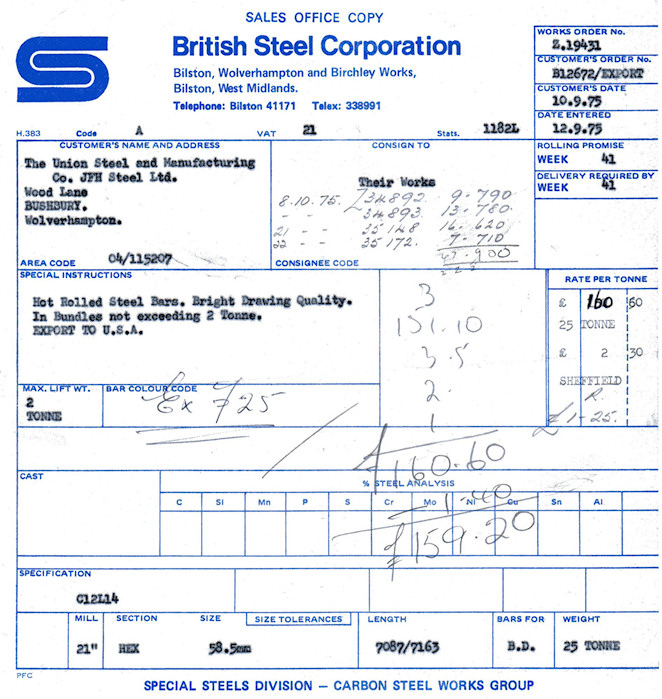
- Tony Harrison
- Brian Shepherd
- Gerry Fieldhouse
- Keith Price
- Bob Dyke
- Geoff Rowson
- Roger Wood
- Tony Turnbull
- Steve Betts
- Robert Dabbs
- Molly ?
- Ian Hemmings (Accounts)
- Dave Maddocks (Transport Office)
- Rob Hendry (Accounts)
- Peter Marsh (Accounts)
- Bob McGrath (Work-study ?)
OPPOSITE: Sales office copy of an order acknowledgement for one of the larger local bright drawing customers – Union Steel of Bushbury – for 25 tonnes of hexagonal bar in C12L14 which was a freecutting low carbon steel grade. The pricing handwriting is that of Jack Evans while deliveries such as advice note Z34892 on 8th October 1975 for 9.790 tonnes have been noted by Joan Bryan. ‘Z’ numbers denoted shipments from Birchley works. Since Union Steel were exporting these bars to the USA an export rebate was applied which looks to be the £1.40 deduction shown. Union Steel were a good customer and I recall visiting them along with colleagues around this time where we enjoyed a glass of Moet champagne in their boardroom…!

